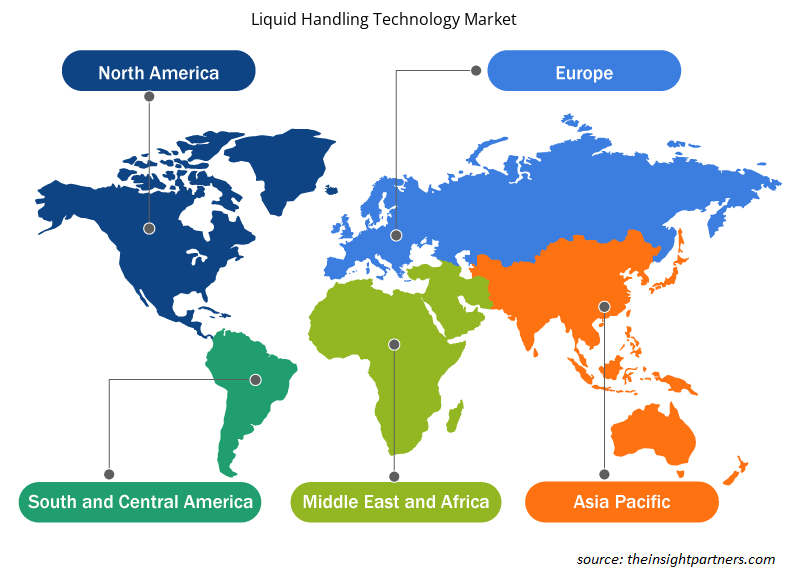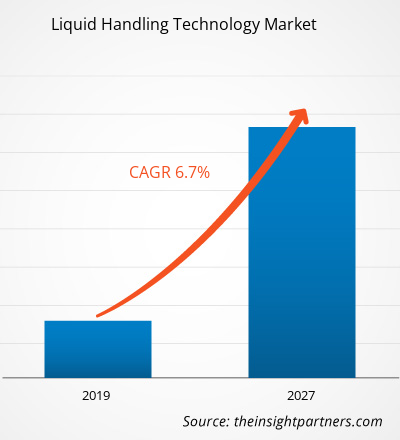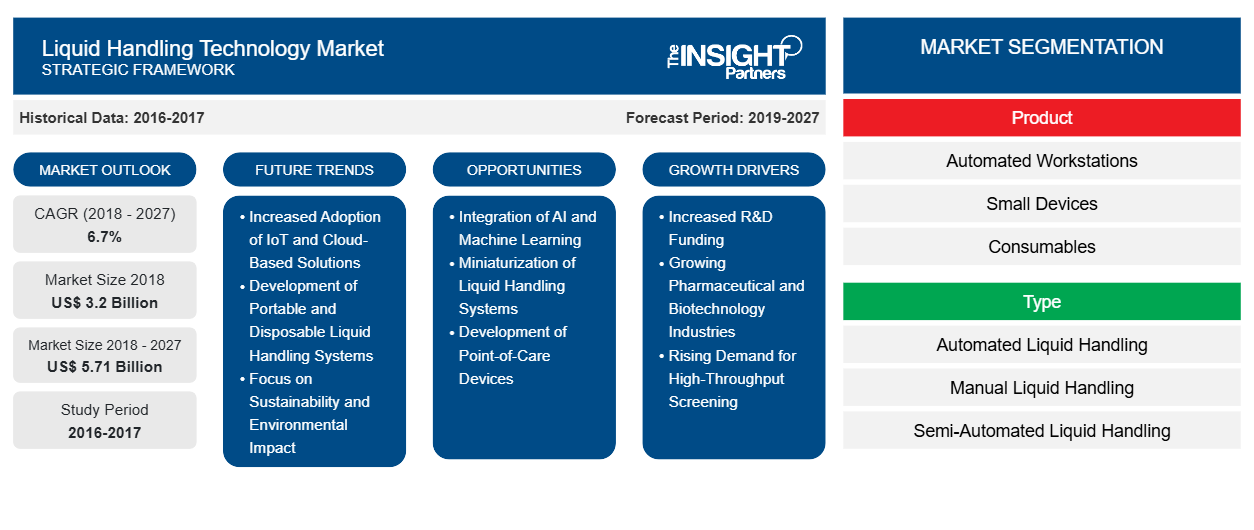بلغت قيمة سوق تكنولوجيا معالجة السوائل 3،201.36 مليون دولار أمريكي في عام 2018 ومن المتوقع أن تصل إلى 5،705.63 مليون دولار أمريكي في عام 2027؛ ومن المتوقع أن تنمو بمعدل نمو سنوي مركب قدره 6.7٪ من عام 2019 إلى عام 2027.
تُستخدم تقنيات التعامل مع السوائل في أتمتة المختبرات الكيميائية أو البيوكيميائية. بالنسبة لهذه التقنيات، تُستخدم أنظمة مختلفة لتوزيع كمية محددة من الكواشف أو العينات أو السوائل الأخرى في حاوية مخصصة. هذه الأنظمة متكاملة برمجيًا مما يسمح للمستخدم بتخصيص إجراءات التعامل مع السوائل وحجم النقل. يُعزى نمو سوق تقنية التعامل مع السوائل العالمية إلى زيادة أنشطة اكتشاف الأدوية وصناعة الأدوية الحيوية المتنامية وارتفاع نفقات البحث والتطوير. ومع ذلك، فإن ندرة المهنيين المهرة هي العامل الرئيسي الذي يعيق نمو السوق.
من المتوقع أن يشهد سوق تكنولوجيا معالجة السوائل العالمية نموًا كبيرًا بعد الوباء. لقد أثر فيروس كورونا المستجد على الاقتصادات والصناعات في مختلف البلدان بسبب عمليات الإغلاق وحظر السفر وإغلاق الشركات. لقد أثقلت أزمة فيروس كورونا المستجد أنظمة الصحة العامة في العديد من البلدان وسلطت الضوء على الحاجة القوية للاستثمار المستدام في أنظمة الصحة. مع تقدم جائحة فيروس كورونا المستجد، من المتوقع أن تشهد صناعة الرعاية الصحية انخفاضًا في النمو. يزدهر قطاع العلوم الحيوية بسبب زيادة الطلب على منتجات التشخيص المختبري وارتفاع أنشطة البحث والتطوير في جميع أنحاء العالم. ومع ذلك، يشهد قطاع التقنيات الطبية والتصوير انخفاضًا في المبيعات بسبب عدد أقل من العمليات الجراحية التي يتم إجراؤها وتأخير أو إطالة أمد شراء المعدات. بالإضافة إلى ذلك، من المتوقع أن تصبح الاستشارات الافتراضية من قبل المتخصصين في الرعاية الصحية نموذج تقديم الرعاية السائد بعد الوباء. مع تحويل التطبيب عن بعد لتقديم الرعاية، ستستمر الصحة الرقمية في الازدهار في السنوات القادمة. بالإضافة إلى ذلك، من المتوقع أيضًا أن تمهد التجارب السريرية المعطلة والتأخير اللاحق في إطلاق الأدوية الطريق للتجارب الافتراضية بالكامل في المستقبل. ومن المتوقع ظهور تقنيات جديدة مثل mRNA وتغيير صناعة الأدوية، ومن المتوقع أيضًا أن يشهد السوق المزيد من التكامل الرأسي والمشاريع المشتركة في السنوات القادمة.
قم بتخصيص هذا التقرير ليناسب متطلباتك
ستحصل على تخصيص لأي تقرير - مجانًا - بما في ذلك أجزاء من هذا التقرير، أو تحليل على مستوى الدولة، وحزمة بيانات Excel، بالإضافة إلى الاستفادة من العروض والخصومات الرائعة للشركات الناشئة والجامعات
- احصل على أهم اتجاهات السوق الرئيسية لهذا التقرير.ستتضمن هذه العينة المجانية تحليلاً للبيانات، بدءًا من اتجاهات السوق وحتى التقديرات والتوقعات.
رؤى السوق
زيادة أنشطة اكتشاف الأدوية لتعزيز نمو سوق تكنولوجيا معالجة السوائل العالمية
إن الزيادة في حالات الإصابة بالأمراض المعدية والأمراض المزمنة مثل السرطان تزيد من الطلب على الأدوية الفعالة. ويدفع الطلب إلى إيجاد دواء فعال قادر على علاج الأمراض بوتيرة أسرع. كما ينشأ الطلب على الطب الدقيق. ومن المتوقع أن تؤدي حالات الإصابة بالسرطان المتزايدة وأنشطة البحث إلى زيادة أنشطة تطوير الأدوية في جميع أنحاء العالم.
إن تطوير الأدوية عملية معقدة تتطلب مدة طويلة وهي عملية مكلفة ومتكاملة مع درجة عالية من عدم احتمال نجاح الدواء. لذلك، فإن تطوير وتكامل الأجهزة الطبية وتكنولوجيا المعلومات مكن من ابتكار المعدات الآلية. سمحت التطورات بتسريع عمليات اكتشاف الأدوية. على سبيل المثال، الفحص عالي الإنتاجية (HTS) هي تقنية تستخدم في اكتشاف الأدوية لفحص عدد كبير من المركبات ذات الهدف البيولوجي. تسمح التقنيات بفحص وتحليل حجم كبير من العينات بكفاءة في وقت أقل. يسمح الفحص عالي الإنتاجية بالتوزيع الدقيق لكميات كبيرة وصغيرة من الكواشف في السوائل.
يهدف اكتشاف الأدوية إلى ربط عمل السائل ببنيته الكيميائية، وبالتالي يتم استخدامه لتحديد المركبات الأكثر نشاطًا. في الوقت الحاضر، يتطلب تطبيق البحث في مجال الرعاية الصحية المزيد من المكونات الصيدلانية والبيولوجية لتطوير الدواء. لذلك، في عملية التطوير، يلزم إجراء فحص معملي لما يقرب من 5000-10000 مادة كيميائية سائلة وعينة بيولوجية لكل دواء جديد معتمد. من بين المركبات التي تم فحصها، يدخل ما يقرب من 250 اختبارًا ما قبل السريري، ويبدأ 5 تجارب سريرية. تستغرق العملية الإجمالية من الاكتشاف إلى تسويق الدواء حوالي 10 إلى 15 عامًا.
كما تشهد الصناعات الدوائية والبيولوجية والتكنولوجية الحيوية وأبحاث علوم الحياة نموًا هائلاً في جميع أنحاء العالم. على سبيل المثال، تمتلك أمريكا الشمالية أكبر صناعة دوائية وبيولوجية، في حين تعد منطقة آسيا والمحيط الهادئ أسرع منطقة نموًا لصناعة الأدوية والبيولوجية. علاوة على ذلك، تتزايد أنشطة البحث والتطوير في جميع أنحاء العالم لصناعة الرعاية الصحية. وبالتالي، من المتوقع أن يؤدي هذا النشاط المتزايد لاكتشاف الأدوية إلى خلق طلب على تكنولوجيا معالجة السوائل في جميع أنحاء العالم. وبالتالي، من المتوقع أن ينمو السوق بشكل كبير خلال فترة التنبؤ.
رؤى قائمة على المنتج
من حيث المنتج، يتم تقسيم سوق تكنولوجيا معالجة السوائل العالمية إلى محطات عمل آلية وأجهزة صغيرة ومواد استهلاكية. في عام 2018، احتل قطاع المواد الاستهلاكية الحصة الأكبر من السوق. كما يُقدر أن يسجل نفس القطاع أعلى معدل نمو سنوي مركب خلال فترة التوقعات.
رؤى مبنية على النوع
بناءً على النوع، يتم تقسيم سوق تكنولوجيا معالجة السوائل العالمية إلى معالجة السوائل الآلية ومعالجة السوائل اليدوية ومعالجة السوائل شبه الآلية. احتل قطاع معالجة السوائل شبه الآلية أكبر حصة في السوق في عام 2018. ومع ذلك، من المتوقع أن ينمو قطاع معالجة السوائل الآلية بأعلى معدل نمو سنوي مركب خلال فترة التوقعات.
رؤى قائمة على التطبيق
من حيث التطبيق، يتم تقسيم سوق تكنولوجيا معالجة السوائل العالمية إلى اكتشاف الأدوية وأبحاث ADME-Tox، وأبحاث السرطان والجينوم، والمعالجة الحيوية/التكنولوجيا الحيوية. في عام 2018، احتل قطاع اكتشاف الأدوية وأبحاث ADME-Tox الحصة الأكبر من السوق. ومع ذلك، من المتوقع أن يسجل قطاع أبحاث السرطان والجينوم أعلى معدل نمو سنوي مركب خلال فترة التوقعات.
رؤى إقليمية حول سوق تكنولوجيا معالجة السوائل
لقد قام المحللون في Insight Partners بشرح الاتجاهات والعوامل الإقليمية المؤثرة على سوق تكنولوجيا معالجة السوائل طوال فترة التوقعات بشكل شامل. يناقش هذا القسم أيضًا قطاعات سوق تكنولوجيا معالجة السوائل والجغرافيا في جميع أنحاء أمريكا الشمالية وأوروبا ومنطقة آسيا والمحيط الهادئ والشرق الأوسط وأفريقيا وأمريكا الجنوبية والوسطى.

- احصل على البيانات الإقليمية المحددة لسوق تكنولوجيا معالجة السوائل
نطاق تقرير سوق تكنولوجيا معالجة السوائل
| سمة التقرير | تفاصيل |
|---|---|
| حجم السوق في عام 2018 | 3.2 مليار دولار أمريكي |
| حجم السوق بحلول عام 2027 | 5.71 مليار دولار أمريكي |
| معدل النمو السنوي المركب العالمي (2018 - 2027) | 6.7% |
| البيانات التاريخية | 2016-2017 |
| فترة التنبؤ | 2019-2027 |
| القطاعات المغطاة | حسب المنتج
|
| المناطق والدول المغطاة | أمريكا الشمالية
|
| قادة السوق وملفات تعريف الشركات الرئيسية |
|
كثافة اللاعبين في السوق: فهم تأثيرها على ديناميكيات الأعمال
يشهد سوق تكنولوجيا معالجة السوائل نموًا سريعًا، مدفوعًا بالطلب المتزايد من المستخدم النهائي بسبب عوامل مثل تفضيلات المستهلكين المتطورة والتقدم التكنولوجي والوعي المتزايد بفوائد المنتج. ومع ارتفاع الطلب، تعمل الشركات على توسيع عروضها والابتكار لتلبية احتياجات المستهلكين والاستفادة من الاتجاهات الناشئة، مما يؤدي إلى زيادة نمو السوق.
تشير كثافة اللاعبين في السوق إلى توزيع الشركات أو المؤسسات العاملة في سوق أو صناعة معينة. وهي تشير إلى عدد المنافسين (اللاعبين في السوق) الموجودين في مساحة سوق معينة نسبة إلى حجمها أو قيمتها السوقية الإجمالية.
الشركات الرئيسية العاملة في سوق تكنولوجيا معالجة السوائل هي:
- شركة اجيلنت للتكنولوجيا
- شركة اورورا بيوميد
- شركة أوتو جين
- شركة داناهر
- مختبرات بيو راد، المحدودة
إخلاء المسؤولية : الشركات المذكورة أعلاه ليست مرتبة بأي ترتيب معين.

- احصل على نظرة عامة على أهم اللاعبين الرئيسيين في سوق تكنولوجيا معالجة السوائل
رؤى تعتمد على المستخدم النهائي
من حيث المستخدم النهائي، يتم تقسيم سوق تكنولوجيا معالجة السوائل العالمية إلى شركات الأدوية والتكنولوجيا الحيوية ومنظمات الأبحاث التعاقدية والمعاهد الأكاديمية والبحثية. احتلت شريحة شركات الأدوية والتكنولوجيا الحيوية الحصة الأكبر من السوق في عام 2018. في المقابل، من المتوقع أن ينمو قطاع منظمات الأبحاث التعاقدية بأسرع معدل خلال فترة التوقعات.
يتبنى اللاعبون العالميون في سوق تكنولوجيا معالجة السوائل استراتيجيات إطلاق المنتجات وتوسيعها لتلبية متطلبات العملاء المتغيرة في جميع أنحاء العالم، مما يسمح لهم أيضًا بالحفاظ على اسم علامتهم التجارية عالميًا.
السوق العالمية لتكنولوجيا معالجة السوائل – حسب المنتج
- محطات العمل الآلية
- الأجهزة الصغيرة
- الماصات
- موزعات
- البيوريتات
- آحرون
- المواد الاستهلاكية
- الكواشف
- نصائح للاستخدام مرة واحدة
- الأنابيب والألواح
- آحرون
السوق العالمية لتكنولوجيا معالجة السوائل – حسب النوع
- التعامل الآلي مع السوائل
- التعامل اليدوي مع السوائل
- مناولة السوائل شبه الآلية
السوق العالمية لتكنولوجيا معالجة السوائل – حسب التطبيق
- اكتشاف الأدوية وأبحاث ADME-Tox
- السرطان والأبحاث الجينية
- المعالجة الحيوية/التكنولوجيا الحيوية
السوق العالمية لتكنولوجيا معالجة السوائل – حسب المستخدم النهائي
- شركات الأدوية والتكنولوجيا الحيوية
- منظمة أبحاث العقود (CRO)
- المؤسسات الأكاديمية والبحثية
السوق العالمية لتكنولوجيا معالجة السوائل – حسب المنطقة الجغرافية
أمريكا الشمالية
- نحن
- كندا
- المكسيك
أوروبا
- فرنسا
- ألمانيا
- إيطاليا
- المملكة المتحدة
- إسبانيا
- بقية أوروبا
آسيا والمحيط الهادئ (APAC)
- الصين
- الهند
- كوريا الجنوبية
- اليابان
- أستراليا
- بقية منطقة آسيا والمحيط الهادئ
الشرق الأوسط وأفريقيا
- جنوب أفريقيا
- المملكة العربية السعودية
- الامارات العربية المتحدة
- باقي منطقة الشرق الأوسط وأفريقيا
أمريكا الجنوبية وأمريكا الوسطى (SCAM)
- البرازيل
- الأرجنتين
- بقية الاحتيال
نبذة عن الشركة
- شركة اجيلنت للتكنولوجيا
- شركة اورورا بيوميد
- شركة أوتوجين
- داناهر (بيكمان كولتر، المحدودة)
- مختبرات بيو راد، المحدودة
- شركة أناليتيك جيهنا
- شركة كورنينج المحدودة
- إيبندورف
- فورمولاتركس، المحدودة
- شركة جيلسون
- التحليل التاريخي (سنتان)، سنة الأساس، التوقعات (7 سنوات) مع معدل النمو السنوي المركب
- تحليل PEST و SWOT
- حجم السوق والقيمة / الحجم - عالمي، إقليمي، بلد
- الصناعة والمنافسة
- مجموعة بيانات إكسل
التقارير الحديثة
شهادات العملاء
سبب الشراء
- اتخاذ قرارات مدروسة
- فهم ديناميكيات السوق
- تحليل المنافسة
- رؤى العملاء
- توقعات السوق
- تخفيف المخاطر
- التخطيط الاستراتيجي
- مبررات الاستثمار
- تحديد الأسواق الناشئة
- تحسين استراتيجيات التسويق
- تعزيز الكفاءة التشغيلية
- مواكبة التوجهات التنظيمية





















 احصل على عينة مجانية ل - سوق تكنولوجيا معالجة السوائل
احصل على عينة مجانية ل - سوق تكنولوجيا معالجة السوائل